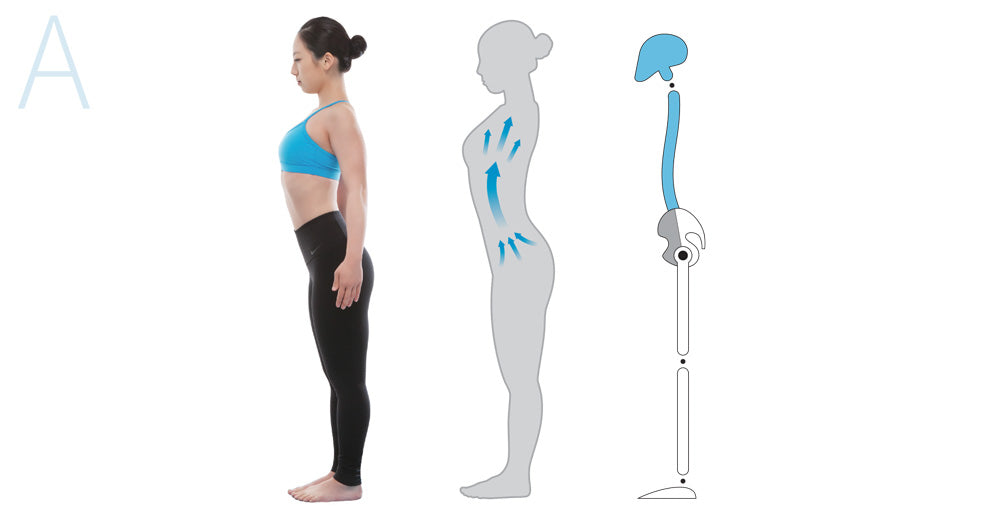Four elements of posture type
This is an excerpt from Identifying Postural Imbalances Through Yoga- Revised Edition by Vayu Jung Doohwa.
Postural type can be divided into four main elements:
- Pelvic tilt
- Spinal curvature
- Breathing
- Energy patterns
After analyzing each of the above elements and observing their repetitive and consistent order of appearance in yoga asana practice, we will be able to identify the postural type.
Type A: Anterior Expansion Type
The strengthening effect of the inhalation pattern on the anterior pelvic tilt and lumbar extension characterize Type A.

In Type A, the hip flexors and erector spinae muscles are short and strong, because of the anterior pelvic tilt (APT). On the other hand, the hip extensors and rectus abdominis muscles are long and weak. Lordosis is excessive, the hip joints are internally rotated, and the feet are pronated.
In general, Type A appears to be expanded with an arched back. The C-shape curvature of the lumbar spine is clear and distinct. The chest is open confidently and the shoulders are rolled back. The tailbone is lifted, and the pubic bone moves downward. A closer inspection will reveal an anterior pelvic tilt.
A represents the anterior pelvic tilt and E the expansion of energy, and so for future reference we can call this Type AE (or simplified as Type A). This type derives from the combination of its most pronounced characteristics of both an anterior pelvic tilt and inhalation-oriented expansion energy patterns.
Type P: Posterior Contraction Type
The strengthening effect of the exhalation pattern on the posterior pelvic tilt and lumbar flexion characterize Type P.

In Type P, because of posterior pelvic tilt (PPT), the hip extensors and rectus abdominis muscles are short and strong. On the other hand, the hip flexors and erector spinae muscles are long and weak. Thoracic kyphosis is excessive. External rotation of the hip joint and a supination pattern of the feet are evident.
In general, Type P appears to be contracted and bent inward. The lumbar spine is flat, while the upper back appears to be stooped. The chest seems to be curved in and the shoulders are rolled in. The tailbone is dropped and the pubic bone moves upward. A closer inspection will reveal a posterior pelvic tilt.
P represents the posterior pelvic tilt and C the contraction of energy, and so it can be called Type PC (or simply Type P). This type derives from the combination of its most pronounced characteristics of both a posterior pelvic tilt and an inward contraction of energy.
Type AE (anterior expansion) and Type PC (posterior contraction) will manifest naturally in the pelvic tilt and the breathing pattern. As the characteristics of the patterns are clear and distinct, they will be relatively easy to recognize.
Type C, described next, is not as easy to identify.
Type C: Complex Type—Kyphotic-Lordotic
The characteristics of anterior pelvic tilt and excessive lumbar lordosis and thoracic kyphosis can all be found in the kyphotic-lordotic Type C.

In Type C, the hip flexors and erector spinae muscles are short and strong.
The anterior pelvic tilt pattern is obvious. However, the hip joints rotate internally and the feet are usually pronated. Careful observation and judgment are required, as the lumbar region and pelvis behave as Type A, while the thoracic region behaves as Type P.
Type C (complex type) is complicated and both the practitioner and the observer may struggle to distinguish this type. There is a lumbar lordosis and an anterior pelvic tilt, similar to Type A, but it is usually more pronounced; moreover, there is a thoracic kyphosis with protracted shoulder blades and internal rotation of the shoulder joints, as in Type P.
When the lumbar and limb patterns are similar to Type A, but the thoracic vertebrae and upper limbs are similar to Type P, this indicates Type C. It is important to emphasize here, however, that Type C is difficult to diagnose correctly.
Type N: Neutral Type
A neutral pelvis, well-balanced curvature of the lumbar and thoracic vertebrae, neutral rotation of the hip joints, and neutral position of the feet are characteristics of Type N.

SHOP

Get the latest insights with regular newsletters, plus periodic product information and special insider offers.
JOIN NOW


